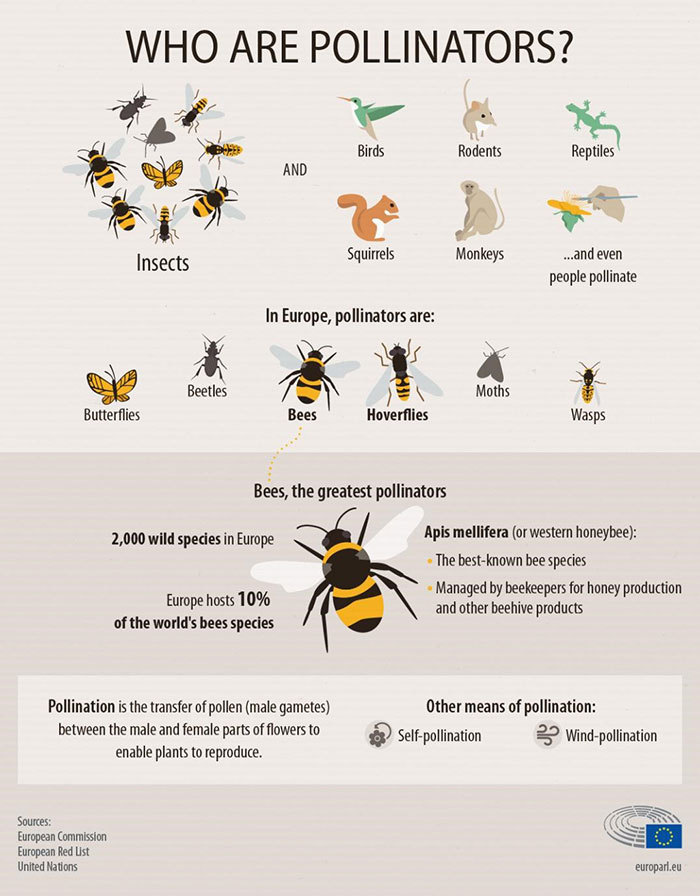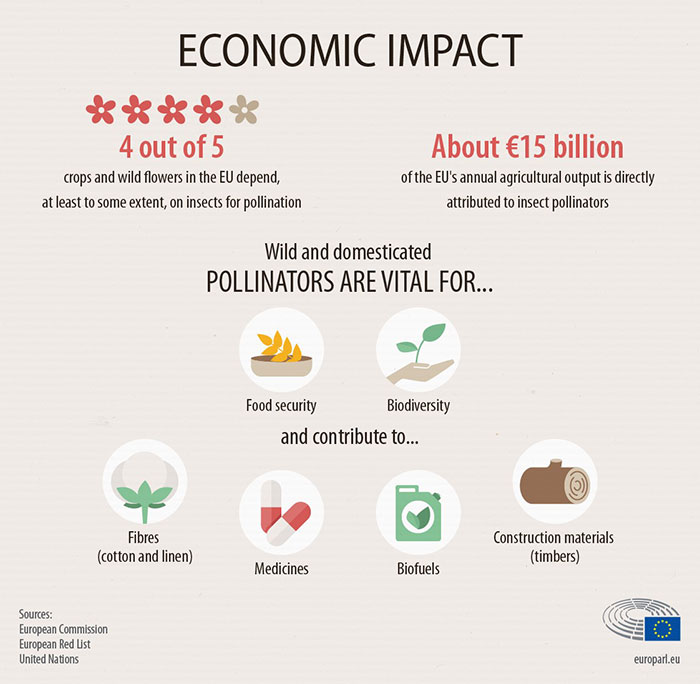Bees and beekeeping, critical issues and perspectives
Entomogamous plants are those that need the intervention of insects for pollination to occur. Pollinating insects and plants over the millennia have undergone a process of co-evolution which has determined a close interdependence between plant and animal species. Over 75% of major agricultural crops and about 90% of wild plants use animals, mainly insects, to transfer pollen from flower to flower and ensure species reproduction (Figure 1).

Figure 1. Infographic showing who pollinators are
Source: www.europarl.eu
This process is the basis for the conservation of natural habitats, as well as for the production of food for animals and humans. It follows that pollination, especially entomophilic pollination, is an essential element of biodiversity, our existence and our economies. The economic value of the pollination service is estimated at about 15 billion euros per year in the EU and worldwide, agricultural production directly associated with pollination represents an estimated economic value of 235 - 577 billion dollars (Figure 2).

Figure 2. Infographic showing pollinator decline statistics and reasons
Source: www.europarl.eu
However, the vital services and benefits provided by bees and other insects are now in danger as the existence of the pollinators themselves is greatly threatened.
The abundance of populations and the state of health of pollinating insects are subjected to various threats and pressures: in Europe, according to the International Union for Conservation of Nature, 9% of bee and butterfly species are at risk of extinction [1].
The decline of pollinators is associated with a series of environmental pressures that often act in synergy with each other, such as habitat destruction, degradation and fragmentation, pollution by physical and chemical agents, climate change and the spread of invasive alien species, parasites and pathogens (Figure 3).

Figure 3. Infographic: key facts about the economic impact of bees and other pollinators
Source: www.europarl.eu
Numerous actions have been taken by the European authorities to investigate in depth the causes that have determined the decline of bees; with decision 2012/362 / EU the European Commission intended to finance a surveillance plan, applied in all Member States, aimed at to monitor the phenomenon of colony loss [2].
The plan, called EPILOBEE, lasted two years (2012-2014) and the main bee diseases were examined in its context: varroasis, American foulbrood, European foulbrood, nosema disease and chronic bee paralysis virus. A web-based database was implemented to allow for the collection and storage of data from all Member States participating in the study. The results of this impressive work are available online on the European Commission website [3].
In 2015, the European Food Safety Authority (EFSA) launched a project to develop a holistic approach to the risk assessment of multiple stressors in bees (MUST-B). The innovative aspect of this project was to consider multiple stressors - chemical, biological or related to environmental factors such as climate change and agricultural practices - together in a single risk assessment framework.
The results of this important work were gathered and analysed in May 2021, when EFSA issued a scientific opinion to the Commission for the Environment, Public Health and Food Safety of the European Parliament, entitled: "A systems-based approach to the environmental risk assessment of multiple stressors in honey bees" [4].According to Bernhard Url, Executive Director of EFSA, this report is of particular importance for those who want to preserve Europe's ecosystems, at the core of which are not only bees, but all pollinating insects.
The climatic changes that have become increasingly evident over the last few decades, have determined a temporal misalignment between the cycle of plants and that of pollinators which, as a macroscopic element, has led to a drastic reduction in annual honey production. In Italy there are 6,864 beekeepers, 1,632,825 hives which, in 2020, produced 18,500 tons of honey, about 50% of the national needs (data from the National Honey Observatory) [5].
With over 30 monoflora and a multiplicity of identity millefiori, our country can count on a heritage of honey that is unique in the world, but despite the quality levels of excellence, the Italian product achieves low average prices, as the market does not recognize an adequate value for national productions. The honey market is heavily conditioned by the large quantities of products from outside the EU (mainly China), whose qualitative characteristics it is legitimate to doubt.
Quoting verbatim the Resolution of the European Parliament of 1 March 2018 on the prospects and challenges for the EU beekeeping sector, we want to underline that: "... honey is the third most adulterated product in the world; this adulteration causes considerable damage to European beekeepers and exposes consumers to serious health risks”; “…. Not all Member States are able to carry out analyzes aimed at identifying irregularities in imported honey”.
For the reasons we have explained above, the community has all the interest in supporting beekeeping producers, as the permanence of bees in the area depends on them.
What can be done, in practice, to pursue this goal?
- Implement support measures for beekeeping, compatible with the constraints imposed by the EU, as bees represent a common good to be protected, beyond the interests of operators in the sector;
- to identify reliable analytical methods to detect the counterfeiting of honey, guaranteeing consumers an authentic product and beekeepers a fairer market;
- to strengthen to consumers of the characteristics of national honeys guaranteed by the local producer, in order to justify the considerable price difference compared to the unqualified honey that they find on supermarket shelves.
The research plays a role of primary importance, through the development of reliable methods of analysis for the identification of the possible presence of foreign substances in the honey offered for sale, as well as for the determination of its botanical and geographical origin, another aspect subject to frequent commercial fraud.
This challenge was taken up by the IZSAM researchers who have an ambitious project in the pipeline aimed at achieving the goal of protecting and enhancing the image of honey, hence beekeepers, the category of agricultural entrepreneurs who, in fact, guarantees the protection of bees.
References
- Bellucci V., Piotto B., Silli V. (a cura di), (2021). Piante e insetti impollinatori: un’alleanza per la biodiversità. ISPRA, Serie Rapporti, 350/2021
- 2012/362/UE: Decisione di esecuzione della Commissione, del 4 luglio 2012, relativa a un contributo finanziario dell'Unione a determinati Stati membri per sostenere gli studi di sorveglianza volontaria sulle perdite di colonie di api
- Laurent M., Hendrix P., Ribiere - Chabert M. and Chauzat M.P. (2016). A pan-European epidemiological study on honeybee colony losses 2012-2014 European Union Reference Laboratory for honeybee health (EURL) Anses
- EFSA scientific committee (2021) A systems‐based approach to the environmental risk assessment of multiple stressors in honey bees. EFSA Journal 2021;19(5):6607
- Osservatorio Nazionale del miele.
Useful links
- Centro di Collaborazione dell'OIE per le Buone Pratiche di Gestione dell'Apicoltura e le Misure di Biosicurezza nel Settore dell'Apicoltura
- Giornata mondiale delle api / 21 maggio 2021
- Sanità delle api e qualità delle produzioni apistiche: ricercatori e apicoltori europei insieme nel progetto “BPRACTISES” / 23 dicembre 2020
- Dipendiamo tutti dalla sopravvivenza delle api / 3 giugno 2020
- Pesticidi e api: revisione delle linee guida
- L'autostrada delle api... da Montorio a Teramo fino a Giulianova
- Apicoltura. Il questionario Coloss 2021/2022 sulla perdita di colonie
- L'apicoltura, un bene comune da difendere con tenacia
- La nuova anagrafe delle api.
Luciano Ricchiuti
Istituto Zooprofilattico Sperimentale dell'Abruzzo e del Molise "G. Caporale" (IZSAM)
Territorial headquarters of Lanciano